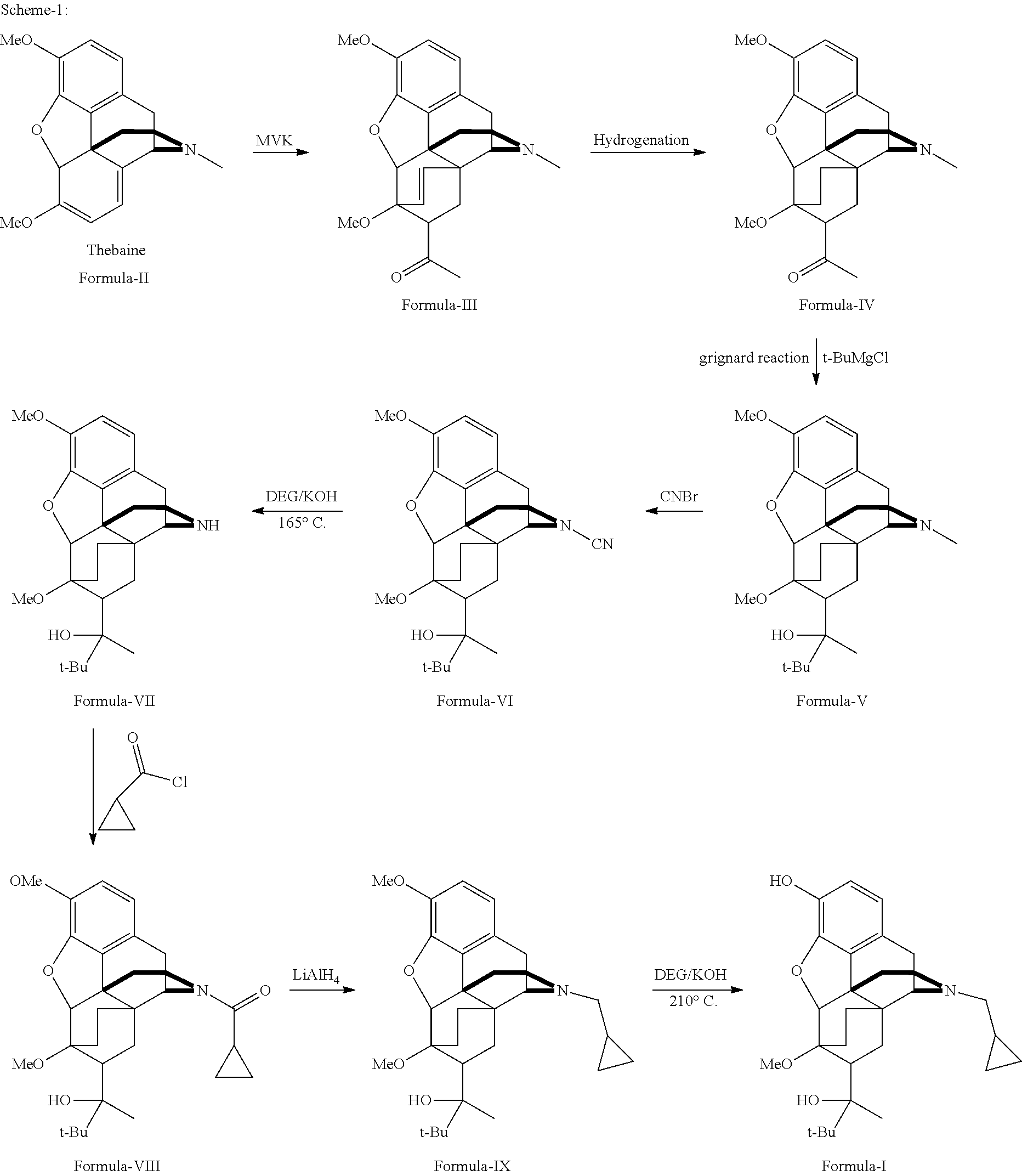Industrial process for the preparation of buprenorphine and its intermediates
a technology of buprenorphine and intermediates, applied in the field of industrial process for the preparation of buprenorphine and its intermediates, can solve the problems of unsuitable industrial scale process, inconvenient preparation process, and inability to mention the purity of product and intermediates, so as to improve the quality of the final product, yield and purity, the effect of high yield
- Summary
- Abstract
- Description
- Claims
- Application Information
AI Technical Summary
Benefits of technology
Problems solved by technology
Method used
Image
Examples
example 1
Preparation of TA of Formula-III
[0133]50 kg of thebaine was added to 100 L dry toluene, and the mixture was cooled to 15° C. 25 L of MVK was added to the cooled mixture and stirred for 30 minutes, followed by stirring at 80° C. to 85° C. for 18 hours. The solvent was removed under reduced pressure and the residual mass was stripped off with isopropyl alcohol, cooled to room temperature and stirred for 1 hour. The resultant product was isolated and dried to get 57.01 kg product TA (Yield: 93.28%; HPLC purity: 99%).
example 2
Preparation of TAR of Formula-IV
[0134]60 L of isopropanol, 6 kg of TA and 250 g of 10% Pd—C catalyst were charged into a 100 L autoclave and hydrogenated at 100 PSI for 3 to 4 hours at 80° C. to 85° C. The charcoal was filtered off under hot conditions and the solvent was partially removed, the remaining mixture was cooled to room temperature and stirred for 2 hours. Finally, the product was filtered to get 5.58 kg TAR (Yield: 92.53%; HPLC purity: 99.5%).
example 3
Preparation of TARG of Formula-V
[0135]Under an inert atmosphere and anhydrous conditions, 1 kg of magnesium turnings and iodine was charged into a vessel. To this was added 3.5 L of CPME. 1 L of t-butyl chloride was added to the mixture under stirring. The mixture was heated slowly and maintained below reflux temperature, until the reaction started. A further 5 L of t-butyl chloride and 30 L of CPME was added to the reaction mixture at such a rate that reaction did not subside. After the addition was completed, the reaction mixture was stirred for 12 hours at 35° C. to 40° C. 1 kg of TAR in CPME was added to the reaction mixture and stirred at 35° C. to 40° C. for 10 hours. The reaction mixture was cooled and quenched with ammonium chloride in 70 L of water. Suitable work up gave 710 g TARG (Yield: 61.18%; HPLC purity: 98.74%).
Same Reaction Scaled-Up to 10 Kg:
[0136]10 kg of magnesium turnings and iodine was charged into a 1000 L vessel under an inert atmosphere and anhydrous conditi...
PUM
| Property | Measurement | Unit |
|---|---|---|
| temperature | aaaaa | aaaaa |
| temperature | aaaaa | aaaaa |
| temperature | aaaaa | aaaaa |
Abstract
Description
Claims
Application Information
 Login to View More
Login to View More - R&D
- Intellectual Property
- Life Sciences
- Materials
- Tech Scout
- Unparalleled Data Quality
- Higher Quality Content
- 60% Fewer Hallucinations
Browse by: Latest US Patents, China's latest patents, Technical Efficacy Thesaurus, Application Domain, Technology Topic, Popular Technical Reports.
© 2025 PatSnap. All rights reserved.Legal|Privacy policy|Modern Slavery Act Transparency Statement|Sitemap|About US| Contact US: help@patsnap.com



